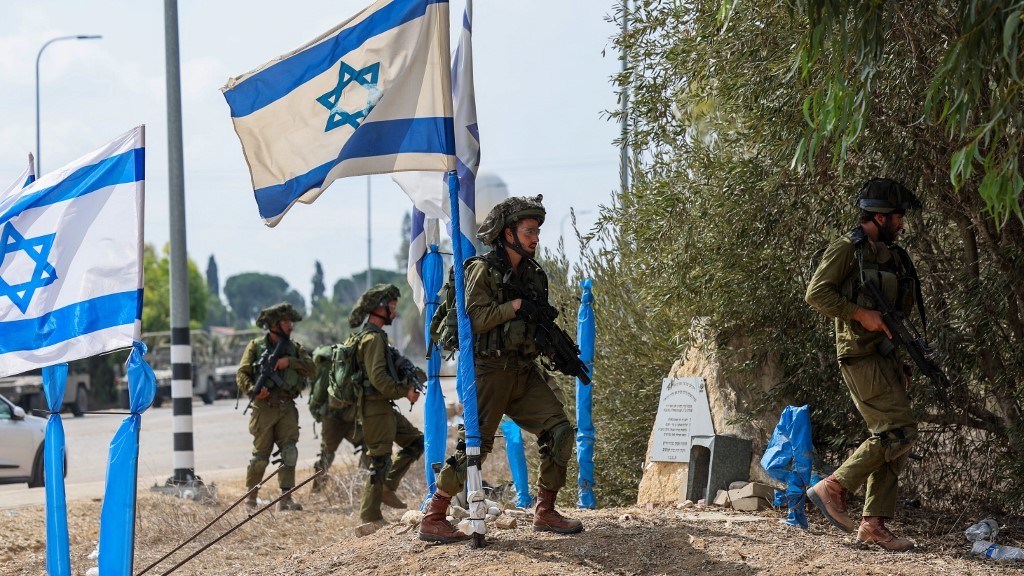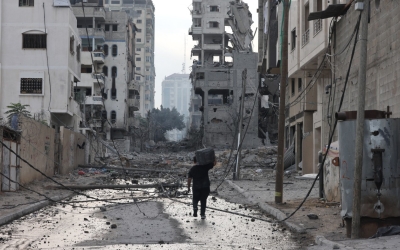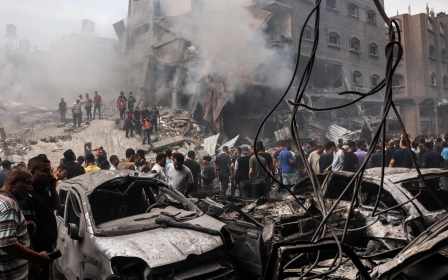Ground invasion of Gaza: What Israel learned from last time

Israel is massing tens of thousands of troops near the Gaza Strip, in what increasingly looks like preparation for a ground operation, days after an assault by Hamas left hundreds of Israelis dead or missing.
Israeli forces have already rained down a barrage of air strikes on the beseiged enclave, killing at least 700 people.
On Saturday, Hamas launched a surprise multi-front assault on Israeli communities near Gaza, firing thousands of rockets and sending fighters into Israel across land, air and sea. Around 800 Israelis were killed, and 130 people taken captive back to Gaza.
Prime Minister Benjamin Netanyahu immediately declared a state of war, while Defence Minister Yoav Gallant ordered “a complete siege” on Gaza.
Around 300,000 reserve soldiers have been mobilised by Israel, and Netanyahu has reportedly told US President Joe Biden that a ground assault is necessary.
It would be the first such incursion since the Gaza war in the summer of 2014. That offensive was launched 10 days into a conflict that would last a total of 50 days.
2014 ground operation
Following more than a week of air strikes, Israel launched the rare ground assault on 17 July 2014 with heavy artillery shelling in the towns of Beit Hanoun and Beit Lahiya in the north of Gaza.
On 19 July, Israeli land forces launched a devastating assault on Shujaiya in eastern Gaza. The district is one of the most densely populated areas in the enclave, home to over 90,000 people in just six square kilometres.
Follow Middle East Eye's live coverage for the latest on the Israel-Palestine war
Eleven artillery battalions pummelled the area with 7,000 high explosive shells, while the air force simultaneously dropped 200,000lbs of explosives. Fifty-five Palestinian civilians were killed, of whom 19 were children.
'Most militaries in the 21st century don’t want to do ground operations because it's massively costly to the side that launches it'
- Craig Jones, senior lecturer at Newcastle University
Nearly 700 buildings were completely destroyed, while hundreds of others were severely damaged.
Worse was still to come - on 1 August, the land army launched 1,000 artillery rounds on the southern city of Rafah, backed by air strikes from the skies. Tanks and bulldozers also razed several homes.
The assault killed 75 civilians in a single day, including 24 children.
In total, the two-month conflict saw 6,000 Israeli air strikes and 50,000 tank and artillery shells fired from the ground.
Israeli forces killed an estimated 2,251 Palestinians across the duration of the conflict, including over 500 children. Seventy Israelis were also killed, the vast majority of whom were combatants.
But the 2014 ground operation was "fairly limited in terms of the scope", Andreas Krieg, assistant professor at King's College London's defence studies department, told Middle East Eye, explaining that it was mostly aimed at targeting Hamas's tunnel infrastructure.
"It was about achieving operational objectives, military objectives. It was never about achieving a strategic success," said Krieg. "Had it been a strategic success, Hamas would have been either wiped out or at least incapacitated."
Israel succeeded in the operation objectively damaging the tunnels, but on a wider level it failed to deeply penetrate Hamas's infrastructure. It also came at a significant human cost.
Sixty-five soldiers were killed in total, a relatively high death toll given that Israeli aggression on Gaza had previously mostly come from the skies, with little risk to its personnel.
“Most militaries in the 21st century don’t want to do ground operations because it's massively costly to the side that launches it,” Craig Jones, a senior lecturer at Newcastle University with a focus on the geographies of international law, told Middle East Eye.
He cited Israel’s operation in 2014, as well as the US operations in Iraq and Afghanistan, and Russia’s ongoing invasion of Ukraine.
“The Israeli military has, like it or not, an amazing capacity in the air. It can commit maximum casualties with minimal damage,” he said. “But putting your soldiers next to enemy forces is dangerous and costly.”
Of the 65 killed, the bodies of two troops, Oron Shaul and Hadar Goldin, are believed to be still held in Gaza to this day - a matter of huge domestic political attention over the past decade.
Soldiers suffering PTSD
As well as the deaths, the trauma suffered by those Israeli soldiers who participated in the 2014 operation has been well documented.
The Israeli defence ministry’s own data showed that of 481 former soldiers recognised as disabled due to the 2014 conflict, 143 suffer from post-traumatic stress disorder (PTSD).
A recent study found that those who took part in the offensive had double the PTSD symptoms compared to other active veterans, even over five years after the conflict. Parents of those who were involved also suffered from secondary traumatic stress.
In 2021, one of those veterans who served in the operation and was diagnosed with PTSD set himself on fire, suffering extensive burns.
A year later, a 27-year-old who was severely injured in the operation and suffered PTSD committed suicide.
The physical and mental toll of the effort is likely to have contributed to Israel's reluctance to launch a ground assault again, including during the escalation in violence in May 2021.
"Many of the younger soldiers and officers don't have the combat experience to to deal with what might potentially be coming," said Krieg.
"The [Israeli military] has been degraded to a great extent from an operational military that can do intensive combat operations to an occupational force."
Lawfare on battlefield
The 2014 ground operation was one of the first times Israel used the concept of “lawfare” as a military tactic.
“Lawfare is the use of formal or informal law, or legal language, for military purposes,” said Jones, who has written extensively on the use of military lawyers by Israel in Gaza.
In the 2014 conflict, lawyers served as legal advisers to Israeli military commanders on the battlefield, particularly during the ground operation, to define levels of risks.
'The law isn’t something that restricts or prohibits military action. Often lawfare is used as a tactic for the multiplication of force'
- Craig Jones, senior lecturer at Newcastle University
Jones noted that while part of it was with a view to international law considerations, it was also, more cynically, used by Israel as a proactive tactic of war.
“The law isn’t something that restricts or prohibits military action,” he said. “Often lawfare is used as a tactic for the multiplication of force.”
One example was in Shuja’iya, where, after dropping leaflets to warn of an impending operation, Israeli ground and air forces used a huge amount of firepower.
“That’s the darker side of lawfare. Once those warnings are issued… it gives carte blanche to turn an area into a kill box,” said Jones.
Another initiative used by Israel was the Hannibal Protocol, an Israeli domestic rule of engagement that stipulates that if a soldier is kidnapped, then it can loosen its precautions and act more aggressively.
“The Hannibal Protocol is the idea that you can destroy anything in a particular area because a soldier has been captured,” said Jones. “The gloves come off and they will do anything they can to get that soldier back, as quick as possible.”
The protocol was used during the huge attacks on Rafah on 1 August 2014, when a soldier went missing.
While the directive is not an international law concept, Jones points out that international law takes into consideration the “military advantage” gained from excessive force in the instance of a kidnapping.
Given the number of hostages taken by Palestinian groups in recent days, the Hannibal Protocol may come into play once again.
“It’s another major weight on the scale of military advantage. If asked ‘Why are you killing people?’ Israel will respond ‘Because we’re hoping to find this grandmother or this girl kidnapped from a festival,’” Jones said.
Despite all its efforts employing military lawyers, Israel came under intense scrutiny for its conduct in the 2014 war in the years that followed, including over its ground invasion.
The UN found potential war crimes committed by Israel and Palestinian groups, while the ICC also launched an investigation into both sides actions during the conflict.
There was domestic backlash too; a 240 page report by Israeli veteran group Breaking the Silence, which interviewed more than 60 soldiers who partook in the war, found that soldiers were told to open fire in Gaza in an indiscriminate manner.
Jones does not think that such accusations of war crimes and abuses will deter Israel from a ground incursion this time round.
"Israel's interpretation is that the law allows its military to commit mass violence," he said.
If you need support in the UK, then the Samaritans can be contacted at [email protected] or on 116 123. For the US, please try the National Suicide Prevention Lifeline on 1-800-273-8255. For other countries, please see befrienders.org.
This article is available in French on Middle East Eye French edition.
Middle East Eye propose une couverture et une analyse indépendantes et incomparables du Moyen-Orient, de l’Afrique du Nord et d’autres régions du monde. Pour en savoir plus sur la reprise de ce contenu et les frais qui s’appliquent, veuillez remplir ce formulaire [en anglais]. Pour en savoir plus sur MEE, cliquez ici [en anglais].







